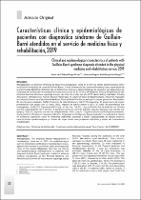Características clínica y epidemiológicas de pacientes con diagnóstico síndrome de Guillain Barré atendidos en el servicio de medicina física y rehabilitación en el año 2019
Related Resource(s)
http://cmhnaaa.org.pe/ojs/index.php/rcmhnaaa/article/view/619Date
2020-06-03Author(s)
Burga-Bravo, Anaís De Faatima
Madalengoitia-Rangel, Susana Milagros
Metadata
Show full item recordAlternate title
Clinical and epidemiological characteristics of patients with Guillain-Barré syndrome diagnosis attended in the physical medicine and rehabilitation service, 2019
Abstract
Introducción: La Gerencia Regional de Salud en Lambayeque, lanza en el 2019 la alerta epidemiológica sobre notificación inmediata de casos de Guillain Barré, frente al aumento de casos confirmados y casos sospechosos de la enfermedad Objetivo: Describir las características clínicas y epidemiológicas de pacientes con diagnóstico de Síndrome de Guillain Barré atendidos en consulta externa en el Servicio de Medicina Física y Rehabilitación del Hospital Nacional Almanzor Aguinaga Asenjo, durante los brotes del año 2019. Materiales y métodos: Estudio descriptivo, retrospectivo. Fueron 48 casos registrados en la base de datos de Epidemiología, 25 fueron evaluados en Consulta Externa en el Servicio de Medicina Física y Rehabilitación; se excluyó 1 caso por gestación. Resultados: De los 24 casos evaluados; 14(58,3%) fueron de sexo femenino y 10(41,7%) masculino. El grupo etario de mayor presentación fue adulto con 12 casos (50%), seguido de adulto mayor 6 (25%). El lugar de procedencia fue Lambayeque, 16 (66,7%); Cajamarca 7(29,2%) y La Libertad; 1 (4.2%). La presentación fue ascendente con 15 casos (62,5%) y descendente con 9 (37,5%). 6 pacientes (25%) no lograron marcha; 3(12,5%) lograron una marcha con apoyo y 15 (62,5%) lograron una marcha independiente. Solo 1 caso (4,17%) presentó afectación de pares craneales. Se encontró arreflexia en 13 pacientes (54,2%). Ningún paciente llegó con fuerza muscular en escala de 0 a 1 tanto en miembros superiores como en miembros inferiores, proximal y distal. Conclusiones: El estudio muestra características epidemiológicas y clínicas de importancia para proyectar objetivos y metas del tratamiento rehabilitador. Introduction: The Regional Health Management in Lambayeque, launches in 2019 the epidemiological alert on immediate notification of Guillain Barré cases, against the increase in confirmed cases and suspected cases of the disease Objective:Describe the clinical and epidemiological characteristics of patients with diagnosis Guillain Barré Syndrome treated in external medical consultation at the Physical Medicine and Rehabilitation Service of the Almanzor Aguinaga Asenjo National Hospital, during the outbreaks of the year 2019.Materialsandmethods:Descriptive, retrospective study. There were 48 cases registered in the Epidemiology database, 25 were evaluated in External Consultation in the Physical Medicine and RehabilitationService;1caseperpregnancywas excluded. Results:Of the 24 cases evaluated; 14 (58.3%) were female and 10 (41.7%) male. The age group with the highest presentation was an adult with 12 cases (50%), followed by an older adult 6 (25%). The place of origin was Lambayeque, 16 (66.7%); Cajamarca 7 (29.2%) and La Libertad; 1 (4.2%). The presentation was ascending with 15 cases (62.5%) and descending with 9 (37.5%). 6 patients (25%) failed to march; 3 (12.5%) achieved a march with support and 15 (62.5%) achieved an independent march. Only 1 case (4.17%) presented cranial nerve involvement. Areflexia was found in 13 patients (54.2%). No patient arrived with muscle strength on a scale of 0 to 1 in both upper and lower limbs, proximal and distal. Conclusions:The studyshowsepidemiologicalandclinical characteristics of importance to project objectives and goals of rehabilitative treatment.






